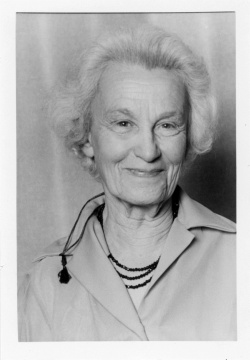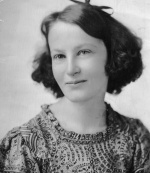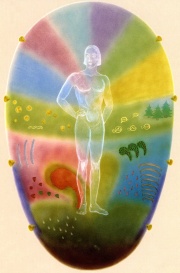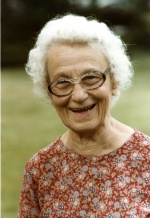Dora van Gelder Kunz: Difference between revisions
Linda Dorr (talk | contribs) No edit summary |
Linda Dorr (talk | contribs) |
||
| Line 42: | Line 42: | ||
As also noted, during World War I the teenage Dora began to assist C.W. Leadbeater in his efforts to contact the recently deceased, for family members who needed reassurance. The war and the world-wide flu epidemic of 1918 made this a heavy workload, one that was very difficult for young Dora. It seems to have been rather a trial by fire — although she was familiar with ''viewing'' the astral plane, she had no training on how to function there. As Mr. Leadbeater was ill, the best he could do was answer her questions; he did not have the time or energy to teach her how to locate people who had passed on, how to interview them, or how to deal with the less savory energies of the astral plane. Dora found it helpful to read or re-read books by Mr. Leadbeater and Mrs. Annie Besant, but she still had to do a great deal of simply learning by doing. | As also noted, during World War I the teenage Dora began to assist C.W. Leadbeater in his efforts to contact the recently deceased, for family members who needed reassurance. The war and the world-wide flu epidemic of 1918 made this a heavy workload, one that was very difficult for young Dora. It seems to have been rather a trial by fire — although she was familiar with ''viewing'' the astral plane, she had no training on how to function there. As Mr. Leadbeater was ill, the best he could do was answer her questions; he did not have the time or energy to teach her how to locate people who had passed on, how to interview them, or how to deal with the less savory energies of the astral plane. Dora found it helpful to read or re-read books by Mr. Leadbeater and Mrs. Annie Besant, but she still had to do a great deal of simply learning by doing. | ||
Dora began teaching meditation at the Theosophical lodge in Sydney when she was 18. She also taught a class on clairvoyance, which she called an “additional sense.”<ref>''A Most Unusual Life'', p. 54</ref> A few years later she would occasionally write about clairvoyance as a regular columnist for the journal ''Theosophy in Australia''. She was 20 when she first wrote about medical clairvoyance, which she compared to being able to read the pages of a closed book.<ref>''Unusual Life'', p. 56</ref> Dora would go on to help develop Therapeutic Touch, a "holistic, evidence-based therapy that incorporates the intentional and compassionate use of universal energy to promote balance and well-being."<ref>http://therapeutictouch.org/what-is-tt/</ref> | |||
== Immigration to United States == | == Immigration to United States == | ||
Revision as of 21:53, 19 June 2019
ARTICLE UNDER CONSTRUCTION
ARTICLE UNDER CONSTRUCTION
Dora van Gelder Kunz (April 28, 1904 – August 25, 1999) was an American writer, psychic, alternative healer, and leader in the Theosophical Society in America, serving as the tenth President of that organization for twelve years.
Note: Unless otherwise stated, the information in this article comes from the book A Most Unusual Life: Dora van Gelder Kunz: Clairvoyant, Theosophist, Healer, by Frank Chelsey and Kirstin Van Gelder. Wheaton, Illinois: Quest Books, 2015.
Early life
Dora van Gelder was born on a sugar plantation on the island of Java, in what is now Indonesia. (In 1904 this southeast Asian country was known as the Dutch East Indies.) She was the eldest of four children, with three younger brothers. Both of Dora's parents were members of the Theosophical Society; her mother was president of the local lodge for some years, and the family hosted lodge meetings as well as speakers visiting from out of town. From the age of seven or so, Dora — a quiet, somewhat shy child — sat and listened during Theosophical meetings. She had already begun meditating, since her mother began teaching the children to meditate when they were five or six. The family library also interested Dora, who, while still a young girl, read various Theosophical works by Mme Blavatsky, Annie Besant, and C.W. Leadbeater. Like her mother and grandmother, Dora was clairvoyant, and she appreciated Besant and Leadbeater’s book Thought Forms, which is illustrated. The book allowed her to compare their impressions with her own.
While Dora's three brothers were her playmates and classmates — the children were tutored at home — as the only girl in the family she sometimes found life rather lonely. It was still the Victorian age, and the life of a girl was quite restricted. Dora loved the natural world and, with no girlfriends her own age, she spent much of her time outdoors. Many (if not most) children are aware of nature spirits, and for Dora these beings were her beloved playmates. Her parents encouraged this interest.
Her maternal grandmother was widowed young and came to live with Dora's family. "Oma" was an herbalist with extensive knowledge and experience, in a place where doctors were few and far between, so she had many local clients. Dora had a deep bond with her grandmother, and the practicality and compassion she learned from Oma carried over into her adult life as an alternative healer.
Dora first met C.W. Leadbeater in 1911, when she was seven and he stayed with her aunt and uncle during his first visit to Java. During his second visit, in 1914, he stayed with Dora's family and noted both her shyness and her clairvoyance. Shortly after he left Java for Australia, World War I began. Due to the war, Mr. Leadbeater decided to stay in Sydney and start a school for children from Theosophical families. Having determined Dora's clairvoyant abilities, he wrote to her parents and asked that she be allowed to attend his school. By now Dora was 12, and her parents told her it was her decision. She was to meditate on it and they would abide by what she decided.
Perhaps needless to say, Dora had some doubts about going, but in the end she felt sure it was the right thing for her to do. She would explain to her own students later that intuition coming from beyond our personality comes with a feeling of resolution.
Life in Australia
Twelve-year-old Dora arrived in Sydney in late 1916, accompanied by her mother's sister. Tante Bet may have been the perfect chaperone and role model for Dora's situation — she was a suffragette who ran her own business, wore pants and suit jackets, and kept her hair short. As a woman who did not worry about other people's opinions, Bet helped Dora adjust to being the only girl in a student body of seven. The six boys had already begun their studies, and they already spoke English, which Dora had to learn.
A few months later, Mr. Leadbeater fell ill and was bedridden for a time. Another problem was that the school, although nominally coeducational, had no residential facilities for girls. Finally, Tante Bet had a business to run back home, so she and Dora returned to Java for a short time. Then Mrs. Annie Besant, the International President of the Theosophical Society, sent a woman doctor to Sydney to take care of Mr. Leadbeater. Dr. Mary Rocke was willing to be Dora's guardian, which Dora's parents also agreed to. So, Dora decided to return to Sydney, this time completely alone. In later years she reflected that
- [It] was a very decisive moment. My God, it changed my life, totally. ... I was never a child again in one way — I learned independence. I mean if you're alone in a foreign country you either break or fall [apart] ... I don't know what my life would have been or not have been; I can't tell you, but I chose it, not my parents.[1]
Although by 1920 there were more girls than boys at the school, Dora's initial role as the only girl meant she became Dr. Rocke's assistant. Having grown up with three brothers, Dora was well acquainted with accidents and injuries. While as an adult she came to be well known for her abilities as a healer, at the time she didn't particularly like nursing. She never held it against the boys, however — they became her family, and she considered them as such throughout her life.
World War I was under way during Dora's first couple of years in Sydney. Mr. Leadbeater, well known for his clairvoyance, had long been asked by Theosophists and others to contact deceased loved ones on "the other side." War casualties, of course, greatly increased these requests. As Mr. Leadbeater was still quite ill, he asked Dora to help him. She found the task of locating and interviewing the recently deceased to be very difficult; among other things, she had to learn to keep her emotions in check and simply pay attention to the job at hand. After each encounter, Dora dictated a letter to Mr. Leadbeater's secretary, who then gave it to him to read and sign. Dora continued to help him with these requests for several years after the war ended.
In 1919, Dora's family — her parents, three brothers, and grandmother — moved from Java to Sydney. Dora remained a student at Mr. Leadbeater's school while her brothers attended the local high school. Her parents immediately became involved with the local Theosophical group, which was thriving.
Clairvoyance
As already noted, Dora became aware of the deva realm at a young age. Given her Theosophical household, her interest in angels and fairies was encouraged. She didn't just play with the nature spirits she encountered -- she studied them, not just during childhood but throughout her life. Her book The Real World of Fairies was a record of these studies. The manuscript, written in 1937 during the Depression, was shelved during World War II and then not published until 40 years later, in 1977. The foreword to the first edition was by Claude Bragdon, a Theosophist and architect who noted that new frontiers in science, especially physics, were changing the materialist view of the world: "Astrophysics and chemistry now deal with phantasms which are nevertheless facts."[2] Both he and Dora also commented that the ability to perceive nature spirits has been a constant in human history, reported in every culture and every era.
When she was around 13, Mr. Leadbeater had his students begin clairvoyant investigations of religious ritual. Dora appreciated the opportunity to further her studies of the angelic realm. She participated in the Liberal Catholic Church for several years, and in 1924 wrote an article on these studies for an LCC publication.
As also noted, during World War I the teenage Dora began to assist C.W. Leadbeater in his efforts to contact the recently deceased, for family members who needed reassurance. The war and the world-wide flu epidemic of 1918 made this a heavy workload, one that was very difficult for young Dora. It seems to have been rather a trial by fire — although she was familiar with viewing the astral plane, she had no training on how to function there. As Mr. Leadbeater was ill, the best he could do was answer her questions; he did not have the time or energy to teach her how to locate people who had passed on, how to interview them, or how to deal with the less savory energies of the astral plane. Dora found it helpful to read or re-read books by Mr. Leadbeater and Mrs. Annie Besant, but she still had to do a great deal of simply learning by doing.
Dora began teaching meditation at the Theosophical lodge in Sydney when she was 18. She also taught a class on clairvoyance, which she called an “additional sense.”[3] A few years later she would occasionally write about clairvoyance as a regular columnist for the journal Theosophy in Australia. She was 20 when she first wrote about medical clairvoyance, which she compared to being able to read the pages of a closed book.[4] Dora would go on to help develop Therapeutic Touch, a "holistic, evidence-based therapy that incorporates the intentional and compassionate use of universal energy to promote balance and well-being."[5]
Immigration to United States
Marriage and family life
Activities in TSA
Camp Indralaya at Orcas Island, Pumpkin Hollow Farm, Northeast Federation, New York TS
Therapeutic Touch
Nursing professor Dolores Krieger became acquainted with Dora Kunz in a meditation group. Together they studied the techniques of Hungarian healer Colonel Oszkar Estabany and developed the treatment method called Therapeutic Touch (TT). This was the beginning of a lengthy collaboration in research, healing, and teaching. In 1972, they started to conduct workshops at Pumpkin Hollow Retreat Center, Indralaya, and many other locations, and taught TT to thousands of health care professionals. Practitioners of TT consciously direct flows of energy near the human body to correct imbalances and subtly promote healing. Dora Kunz demonstrated a highly developed sensitivity:
Through the use of this natural ability she was able to perceive blockages and dysrhythms in a patient's energy field, subtle disharmonies not accessible to other medical technologies. Dora diagnosed numerous perplexing cases referred by physicians and other scientists and often suggested treatments and resources for her patients.
Dora's abilities extended beyond the usual sense perception. For example, she was particularly known for her work with the unseen human field energies in an individual. Since childhood Dora was aware of such forces, and she made a lifetime study of how they work and how they relate to attitudes and emotions, this awareness later evolved into an understanding of the universal healing field from which both healers and patients can draw fresh, potent healing energies.[6]
Kunz and Krieger developed methods for teaching these techniques. The Nurse-Healer Professional Association honored Mrs. Kunz in 1980 as "a model researcher, teacher, and practitioner of healing." Dolores Krieger published The Spiritual Dimension of Therapeutic Touch (Rochester, Vermont: Bear & Co., 2004), a compilation of case studies and transcriptions of lectures that had been presented by Dora Kunz.
President of the TSA
Writings
As is customary for Presidents of the TSA, Mrs. Kunz acted as Editor in Chief of the national periodical, The American Theosophist, and she contributed to other Theosophical journals as well. The Union Index of Theosophical Periodicals lists 39 articles by or about Dora van Gelder and over 200 under the name Dora Kunz. She wrote several books:
- The Real World of Fairies: A First-Person Account. 2nd ed., Wheaton, IL: Theosophical Publishing House, 1999. She described her childhood encounters with fairies and devas.
- "Christmas of the Angels" was a popular Christmas talk that has been issued as an audio recording and printed as a pamphlet. [However, Mrs. Kunz left a note disavowing authorship of the pamphlet. See TSA Archives, Kunz Family Collection, Records Series 25.01, Box 22, Folder 16.]
- The Personal Aura. Wheaton, IL: Theosophical Publishing House, 1991. This volume is beautifully illustrated with watercolors of auras painted by Juanita Donahoo under the author's instruction. It has been printed in several editions and languages.
- Spiritual Aspects of the Healing Arts. Wheaton, IL: Theosophical Publishing House, 1985. This was a compilation of articles that was reprinted in 1995 under the name Spiritual Healing.
- The Chakras & the Human Energy Fields: Correlations Between Medical Science and Clairvoyant Observation. Wheaton, IL: Theosophical Publishing House, 1989. Coauthor Dr. Shafica Karagulla. This described medical research with Dr. Karagulla, in which Dora used her perception of auras to describe patient conditions.
Later years
Mrs. Kunz died in Seattle on August 25, 1999 after being a member of the Theosophical Society in America for 80 years. Many friends wrote memorials describing her warmth and compassion, energy, practicality, and the infectious spontaneity of her laughter.
Biographical works
- Chelsey, Frank, and Kirstin Van Gelder. A Most Unusual Life:Dora van Gelder Kunz: Clairvoyant, Theosophist, Healer. Wheaton, Illinois: Quest Books, 2015. A biography by two people who knew her well. Illustrated.
- Karagulla, Dr. Shafica. Breakthrough to Creativity. New York: DeVorss & Company, 1967. This book about psychic abilities has material about Dora Kunz, referring to her by the pseudonym "Diane."
Online resources
Articles
- In Profound Gratitude by Edward Abdill
Videos
- The Structure and Function of the Chakras on YouTube. A case study of how a clairvoyant perceives a patient's chakras and their correlation with the body. From interview on 7/1/1986.
Notes
- ↑ A Most Unusual Life, p. 35
- ↑ The Real World of Fairies: A First-Person Account. Wheaton, IL: Theosophical Publishing House, 1977, p. ix.
- ↑ A Most Unusual Life, p. 54
- ↑ Unusual Life, p. 56
- ↑ http://therapeutictouch.org/what-is-tt/
- ↑ "History of Therapeutic Touch at Pumpkin Hollow Retreat Center," at TherapeuticTouch.org.



